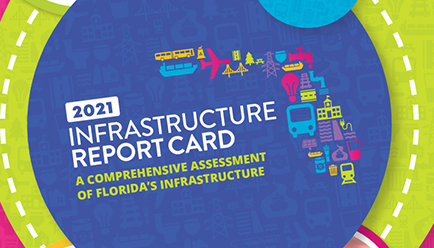On Wednesday, October 27, the Florida Section of ASCE unveiled the 2021 Report Card for Florida’s Infrastructure, the section’s first report card since 2016. The report assigned the state’s systems a cumulative grade of “C”, which is higher than the national grade of “C-“ and consistent with the state’s “C” grade in its previous 2016 report. A “C” grade means the state’s infrastructure is in mediocre to good condition.
The report analyzed 14 categories of infrastructure pertinent to Florida: aviation (C+), bridges (B), coastal areas (C-), dams (D-), drinking water (C), energy (C+), levees (D+), ports (B), roads (C+), schools (D+), solid waste (B+), stormwater (C-), transit (C) and wastewater (C). ASCE Florida Section President Tzufit Boyle, the report card chair, Kathi Ruvarac, and section past-president Peter Moore spoke at the event and detailed the report’s findings. Secretary David Gwynn, FDOT District 7, and state senator Jeff Brandes, Dist. 24, were guest
Florida’s surface transportation sectors – including roads (C+), bridges (B), aviation (C+), ports (B) and transit (C) – comprise one of the highest-performing infrastructure networks in the nation, despite seeing an uptick in 2.7 million residents over the past decade and increasingly severe storms battering assets. Only 31% of Florida’s major roadways are in poor condition, compared to 42% nationally. The Florida Department of Transportation (FDOT) has utilized asset management practices to maintain existing infrastructure before implementing capacity projects for both roads and bridges.
Nearly 65% of Florida bridges are in ‘good’ condition compared to the national value of 45%, while only 3% of Florida’s bridges are in ‘poor’ condition compared to more than 7% nationally. The state’s motor fuels tax – which is used to fund road and bridge maintenance and expansion – has been indexed to adjust with inflation and the state continues to increase transportation related funding; in fiscal year 2021-2022, the state budget allocates $10.3 billion to transportation infrastructure, up from $9.7 billion the previous year.
Despite these strong metrics, from 2017 to 2020 the percentage of Florida’s bridges in ‘good’ condition decreased. The same trend is seen across the United States, but Florida’s change over time occurred more quickly. Florida also reported a slight uptick in bridges considered in ‘poor’ condition from 1.9% in 2016 to 3.2% in 2020.
Aviation (C+) and ports (B) have also performed well. Florida’s airports support more than 170 million annual passengers due to a world-renowned tourism industry, more than 43,000 jobs and $175 billion in economic activity, all sharp rises over the course of a decade. The state’s 15 seaports generate nearly 900,000 jobs and $117.6 billion in economic value.
Florida’s dams (D-), which had the lowest grade in the report, are lacking in up-to-date data and only 41% of them have an Emergency Action Plan, compared with 81% nationally. Similar to dams, only 40% of Florida’s 90 levee (D+) systems have been assessed for risk, despite their role in protecting nearly $100 billion in property and 1.6 million residents.
Meanwhile, Floridians produce nearly triple the national per capita average of solid waste per day, thanks in large part to tourists, but the state recycled 42% of its Municipal Solid Waste, well above the 2018 national average of nearly 24%. Florida has the second largest waste-to-energy conversion rate in the country, generating roughly five million megawatt hours of energy from biomass sources in 2019.
The report also includes calls to action to raise the grades, such as:
- Continue leadership and investment in critical transportation and freight sectors to strengthen the economy and public safety.
- Improve routine data collection and assessment in Schools, Dams, and Levees sectors to expand the public and lawmakers’ access to information to inform safety and funding decisions.
- Expand the application of new approaches, materials, and technologies across Florida’s infrastructure sectors to improve its ability to withstand or quickly recover from natural or man-made hazards.
